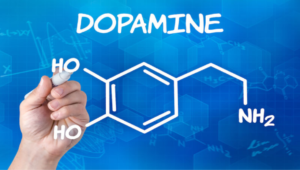While all addictive drugs appear to affect dopamine in the reward pathway in some way, what changes between most of these addictive drugs is the mechanism by which they increase the amount of dopamine in the synaptic space. For instance, drugs called stimulants, like amphetamines and cocaine, which increase the speed of nervous system functioning, usually directly affect dopamine itself.

Cocaine (which produces energy, euphoria, power, and pleasure) works by blocking dopamine reuptake pumps. Normally, after dopamine binds to the receptor on the postsynaptic neuron and allows ions to rush in, a protein pumps known as the dopamine reuptake pumps recycle dopamine back into the presynaptic terminal, to be used again. However, when cocaine blocks these pumps, dopamine cannot be recycled, and more and more dopamine fills into synapse, increasing its amount.

Meanwhile, stimulants known as amphetamines (which increase energy usage, focus, and enjoyment) mimic dopamine by going through dopamine reuptake pumps, replacing the dopamine in the presynaptic vesicles and forcing them all into the synapse. They can’t really return to the synapse because the vesicles are still filled up with these impostor molecules, so they just hang out there in the synapse – constantly accumulating in number.

A few stimulants indirectly increase the amount of dopamine in the synapse. For example, nicotine works by acting on acetylcholine receptors within dopaminergic neurons. Acetylcholine is another type of neurotransmitter that is often used in the same synapse as dopamine; acetylcholine receptors, which are present in nearly every dopaminergic neuron in the reward pathway, act as modulators to help regulate the amount of dopamine secreted into the synapse (in addition to the dopamine reuptake pump). Basically, when acetylcholine binds to an acetylcholine receptor, it allows ions to transfer into the postsynaptic neuron to start sending its electrical signal, just as dopamine does. However, if part of the ion transfer is initiated by acetylcholine and its receptors, that means less dopamine receptors need to act. Consequently, acetylcholine receptors regulate the amount of dopamine released into the synapse. When nicotine binds to acetylcholine receptors, it responds the same way: by allowing some ions into the postsynaptic neuron. Even so, when nicotine binds to the receptor, it remains closed for a longer period of time afterwards. Therefore, less acetylcholine can bind to its receptor, and more dopamine is required. That’s why nicotine often doesn’t act as strongly as other stimulants: it doesn’t increase the amount of dopamine directly or by as much. However, it’s actually more addictive than the others.

Other drugs that decrease the activity of the nervous system are known as depressants, and they act on a variety of pathways – both directly and indirectly affecting the reward pathway. For example, alcohol, one of the most consumed depressants, directly acts on dopaminergic neurons by tampering with the enzyme that breaks down dopamine from postsynaptic receptors and in the synaptic cleft (sometimes dopamine is just broken down instead of recycled through reuptake pumps). Again, this increases the dopamine content in the synapse. However, alcohol’s primary function as a depressant occurs in its action on GABA receptors. GABA receptors allow negatively charged ions, like chloride, into the postsynaptic neuron, sending inhibitory signals and stopping an electrical impulse from being sent. When alcohol binds to these receptors, they stay open for longer, allowing more chloride ions to enter the postsynaptic neuron. This stops more signals from being sent (hence the name ‘depressant’) and causes alcohol’s sedative effect. Alcohol also acts to inhibit the excitatory effect of glutamate on its receptors, playing the role of a depressant in that manner as well.

Meanwhile, a group of depressants known as benzodiazepines, which include xanax, valium, and librium, lower anxiety and stress by acting on GABA receptors, just like alcohol. However, instead of allowing the receptors to remain open for longer, they increase the frequency of how often the receptors open and close – this allows more chloride ions to fill the postsynaptic neuron.
